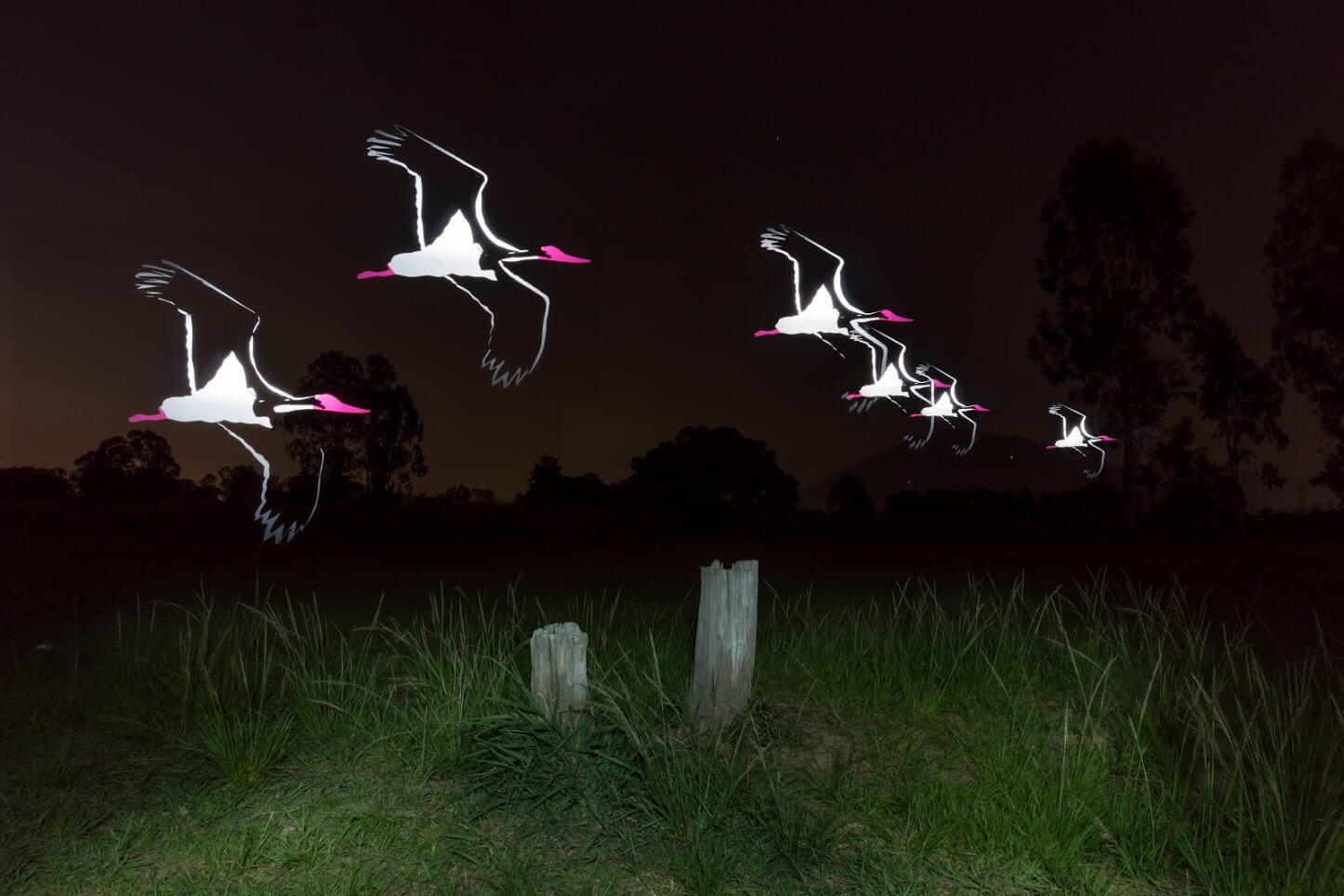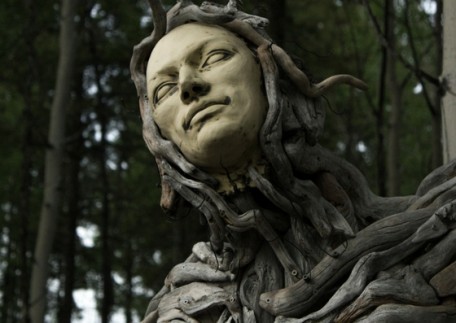Art Projects
Art + Nature Pinterest Board
by CRC Research
Alaska's Chicagof Island as Sheet Music
Music Project by Lauren Oakes and Nik Saw
Barren trunks and dying yellow cedar trees are transforming the rainforest landscape along the Alaskan coast caused by the warming northern climate. To track the effects that climate change is having on this species, Stanford PhD student, Lauren Oakes, collected raw data from forty-eight tree plots. After years of interpretation, music helped Oakes see her research in a whole new light. Using data sonification technology, her colleague, Nik Sawe, translated her data into hauntingly beautiful and melancholic melodies set in the Key of D Minor. The number of trees in each research plot filled individual measures of music. Each note represents a single tree whose unique characteristics are expressed through pitch (height of tree) and force (diameter of tree). According to a Co.Exist article, the species of tree even determines the instrument type with yellow cedars voiced through piano, western hemlock through flute, mountain hemlock through violin and viola, clarinet for shore pines, and finally cello and bass for the Sitka spruce. Denser data plots voice quicker notes while areas with dying or dead trees voice quiet, slow, or even silent notes. What is so striking about this project is how powerful art can be in communicating complex data. It helps the public view climate change through a different sensorial perspective, and in a way, conveys the voice of nature itself.
Bird Eco-Art in Hong Kong: inspiring a new audience
Sculpture and installation project the Hong Kong Birdwatching Society. Article by Christine YM Chan
The Hong Kong Birdwatching Society introduced an innovative program that combines conservation and creativity. Last year, they launched Hong Kong Birds Eco-Art after observing how many artists of all genres had been inspired by the vivid colour and beauty of birds. They invited members of the publie to participate in a series of workshops to create art that depicted birds. The results are breathtaking light stencils, floating platforms, and photography.
Image by Birdwatching Society / Cheung Wai Lok, Matthew Kwan. Retrieved via https://www.birdlife.org/
Edging Forward: Reconnection, Reconciliation, Regeneration
Multi-media project by Ann Dale and Nancyanne Cowell
After realizing that something was missing in conversations on sustainable community development, Ann Dale and Nancyanne Cowell came together to explore some of the missing threads: love, compassion, and the power of storytelling. Art and science are traditionally separate disciplines, with the former focused on expression and creativity and the latter centered on the pursuit of data and discovery. However, given the unprecedented nature and scale of issues our world is facing, they decided that bridging the two disciplines would tell a more compelling story. Edging Forward: Reconnection, Reconciliation, Regeneration is an art and literary project that illuminates the power of collaboration. As the social scientist and artist explore what is holding us back, they bring new perspectives to the conversation about how to leap towards a more sustainable world.
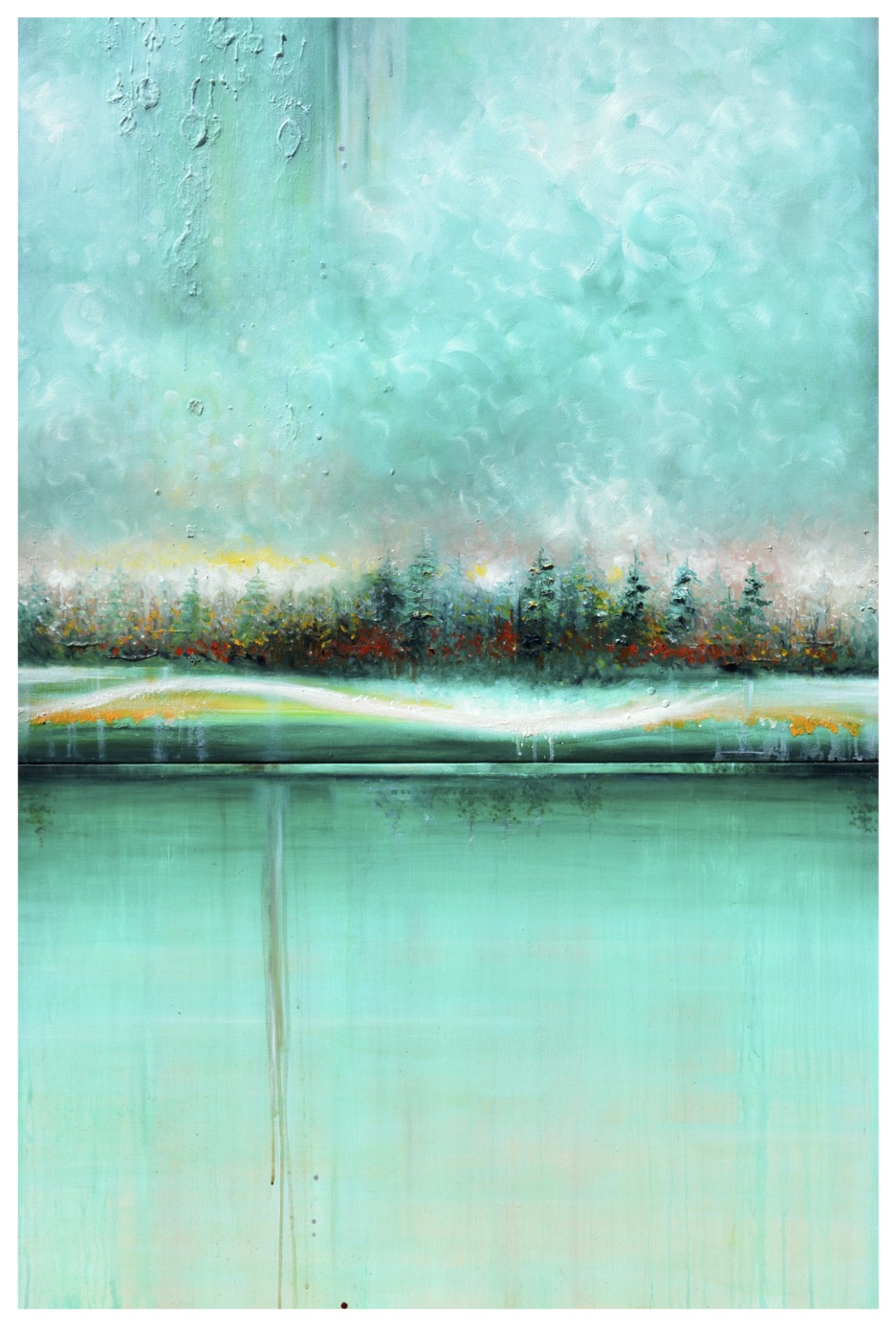
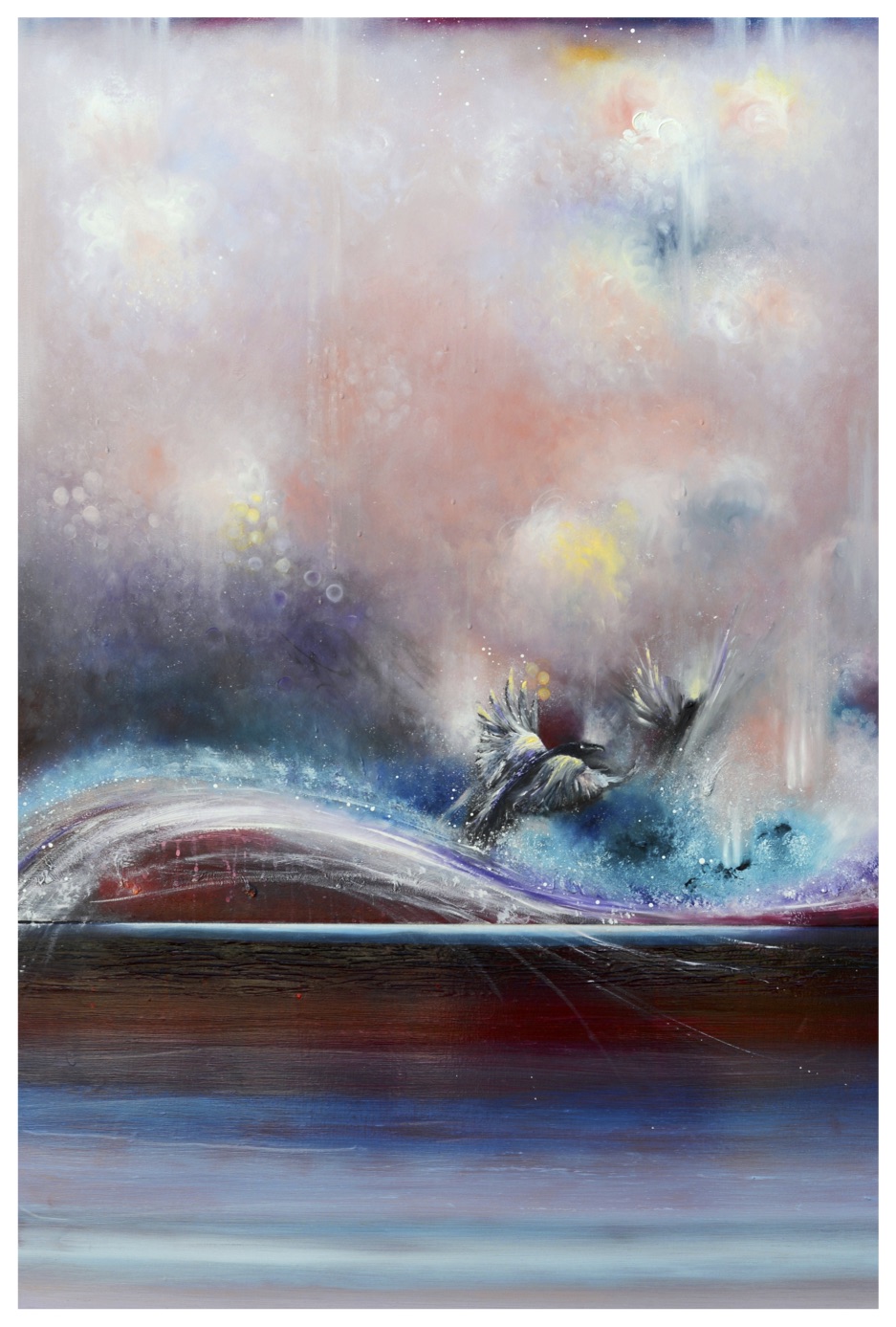
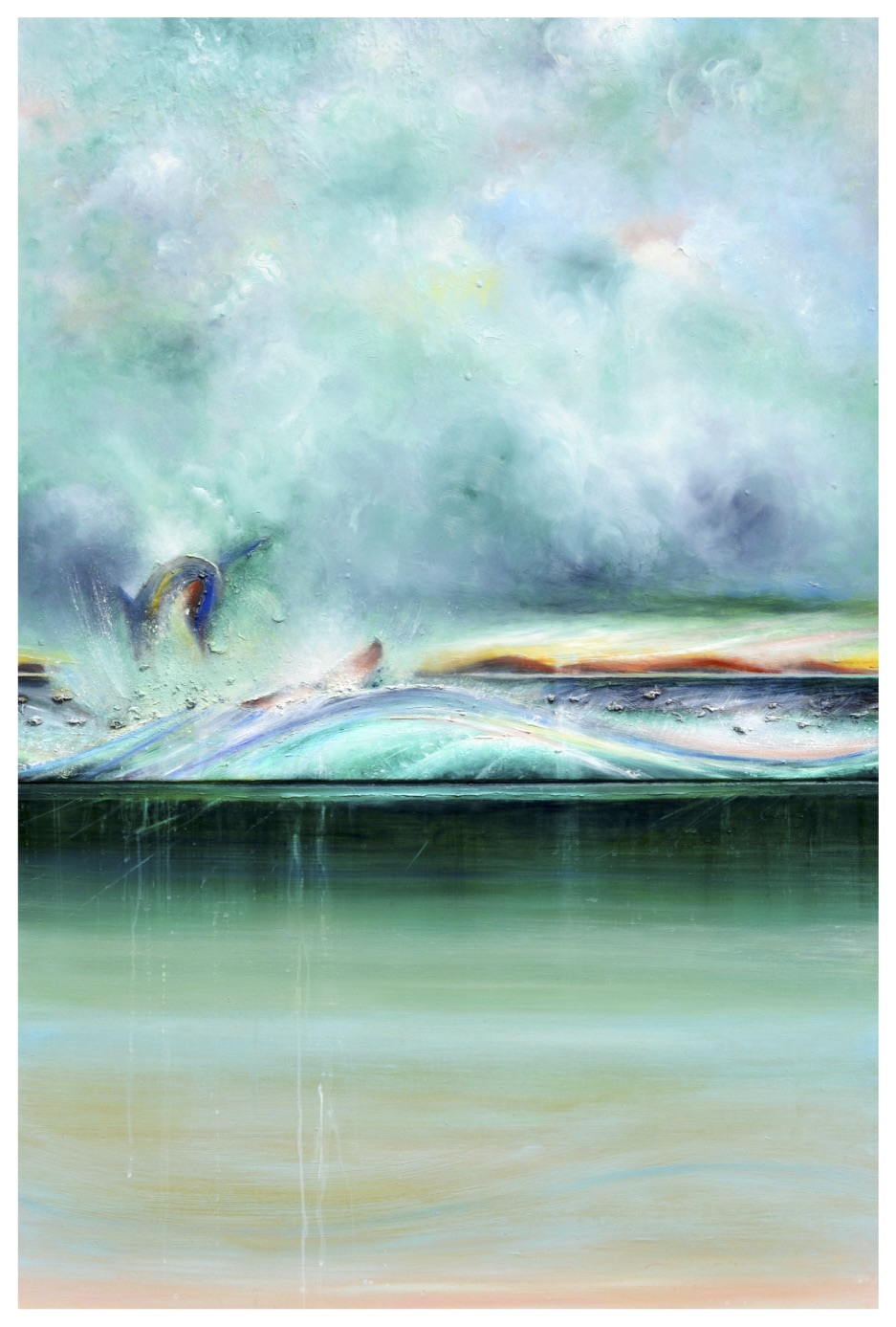
Shades of Wonderland, Their Percussive Heartbeats, and Ecoscape of the Soul by Nancyanne Cowell. Edging Forward Art Collection.
Driftwood Mastodon
Sculpture by Guthrie Gloag
“This sculpture is like nothing I’ve ever made before. It’s of an animal that has been extinct for approximately ten to twelve thousand years, likely because of human pressures. These massive creatures were once widespread across North America. The American mastodon, which is what I’ve created, is the first species that scientists recognized as having gone extinct. In this way, they are fundamental to our understanding of extinction. I learned about mastodons and other mega fauna early on in my Biology degree, and when I started building my sculptures I became fixated on the idea of creating one. I wanted to give myself, and others, the opportunity to see a mastodon in an environment similar to its natural habitat. The only way for me to make that happen was to hike driftwood into the forest, one backpack at a time. This sculpture is over eight and a half feet at the shoulder and likely weighs over two thousand pounds. I’ve kept its location secret for several reasons. Partly, I like the magic of people knowing it exists but not knowing where. I love the idea of someone stumbling upon it in the woods. But I’m also scared that history will repeat itself, and the mastodon will be damaged. I hope that if someone does stumble upon my mastodon, or sees images of it, they might reflect on the animals living today that could be lost due to human impacts. Just as the mastodon became a symbol of extinction, I hope that my sculpture can be a message of conservation." [Text from http://guthriegloag.com/mastodon-project/]
Guthrie Gloag // CBC Arts from Lisa Wu on Vimeo.
Human/Nature
Painting and sculpture by Suzanne Paleczny
Human/Nature, an exhibit currently showing at the Yukon Arts Centre, explores our complex relationship with the natural world. Featuring three-dimensional sculptures and two-dimensional oil paintings by artist, Suzanne Paleczny, this exhibit “asks the viewer about their impact on the natural world. More specifically, how that impact is not always positive”. This exhibit shared during our first biodiversity conservation e-Dialogue with Women for Nature. In communicating the importance of biodiversity, we hope art will share new perspectives.
i Papá Estuvo en la Selva (My Dad Went to the Jungle)
Children's book that sprouts jacarta trees by Pequeno Editor
There are many children’s books that share heartwarming stories of nature and why it needs protecting. But what if our younger readers could learn about ecology while practicing it? One Buenos Aires publishing company has taken this one step further. Pequeño Editor recently printed copies of i Papá Estuvo en la Selva (My Dad Went to the Jungle) that sprout a micro-forest of jacaranda trees, a species native to Argentina. Each edition is printed on handmade paper sewn with seeds and nontoxic inks. Once read (and re-read), the cover should be watered and left in a sunny indoor space to germinate before planting outdoors. The book's materiality echoes the sentiment of the story by encouraging children to deepen their respect for nature. As a non-commercial endeavour, Pequeño Editor circulated copies to various schools, libraries, and educational institutions in hopes of raising the public’s environmental awareness. Suffice it to say, it has been a success.
Tree-Book-Tree Study Case (2015) from Guido Cassini on Vimeo.
Nature/Society/Economy
Sculpture by Tone Bjordam
Art and science are traditionally separate disciplines, with the former focused on expression and creativity and the latter centered on the pursuit of data and discovery. However, given the unprecedented nature and scale of issues our world is facing, many people are realizing that bridging the two disciplines may ultimately tell a more compelling story. Tone Bjordam was brought to tears during a 2013 workshop in Uraguay led by Swedish scientist, Carl Folke. Using a diagram with three concentric circles each representing nature, society, and the economy, he discussed their interconnections. If the economy collapsed, for example, then nature and society would survive. If society collapsed, nature would still prevail. However, if nature collapsed, society and the economy would fall into chaos. So moved by the presentation, the Norwegian visual artist created a biosphere sculpture installation that was suspended from the ceiling at the Resilience 2017 conference in Stockholm, Sweden. Entitled Nature/Society/Economy, Bjrodam’s sculpture is made up of three components according to Megan Rowling in this Rethink article. The upper hanging circle is covered with moss, dirt, and other vegetation. Attached with wires, a smaller disk hangs below and depicts rivers, fields, and city lights. Suspended at the bottom is a coin-covered globe that looks strikingly similar to a disco-ball. Echoing Folke’s discussion during the Uraguay workshop, the sculpture visually illuminates how nature supports both society and the economy. If the wires from the top were ultimately cut, all three elements would collapse. Through a physical manifestation of the nature/society/economy relationship, Bjrodam not only conveyed the beauty and fragility of our environment but also the scientific argument made by Folke.
Nature / Society / Economy from Tone Bjordam on Vimeo.
Photo Ark
Photography by Joel Sartore
The National Geographic Photo Ark, led by photographer Joel Sartore, is a multiyear effort to document every species living in wildlife sanctuaries, inspire action through education, and help save wildlife by supporting on-the-ground conservation efforts.
The Photo Ark - Introduction from Joel Sartore on Vimeo.
Projections of the Photo Ark from Joel Sartore on Vimeo.
ReMediate
Pollinator quilt embedded with native seeds by Christina Kingsbury
The now decommissioned Eastview landfill site in Guelph, Ontario, spans 45 hectares of degraded landscape. It’s hard to tell that this place is home to mountains of waste since its transformation into a vibrant pollinator garden and community park. Filled with wildflowers, trails, and recreational facilities, this massive undertaking was the result of years of planning, fundraising, and site preparation. As there is a continued decline in pollinator populations, multidisciplinary artist, Christina Kingsbury, embarked on a project called ReMediate to reinvigorate the site for local bumblebees, wasps, and butterflies. She crafted a 2,000 square foot quilt made from natural fibers and embedded with native seeds collected from local flora and fauna. Hand-sewn on site with the help of volunteers, the quilt will eventually breakdown and transform into a living garden and habitat for pollinators. ReMediate embodies a wealth of meaning as it explores concepts of place, labour, and ecology through the medium of craft. It evokes the notion of care and acts of reciprocity, often connected to the history homemaking and women’s labour movements. The slow and meticulous quilting process also contrasts the fast-paced fabrication of mass produced waste occupying the ground below. This unique project, though small in scale, demonstrates ways to not only reconnect, but also repair our relationship with the natural world through acts of care.
ReMediate from Christina Kingsbury on Vimeo.
Resilience & World Enough: Tales from the Bottom of the Garden
By Katrine Claasens
Katrine Claassens is a painter from Cape Town, South Africa. She has a degree in Visual Arts from Stellenbosch University (2007) and master's degree in Climate Change from the University of Cape Town (2015). After graduating from her first degree she lived between Quebec and France developing her artistic practice before moving back to South Africa in 2012. Her paintings reflect her interest in climate change, deep ecology, urban ecology, and internet memes. As well as making art, Katrine has worked as climate change communicator at the African Climate & Development Initiative at the University of Cape Town.
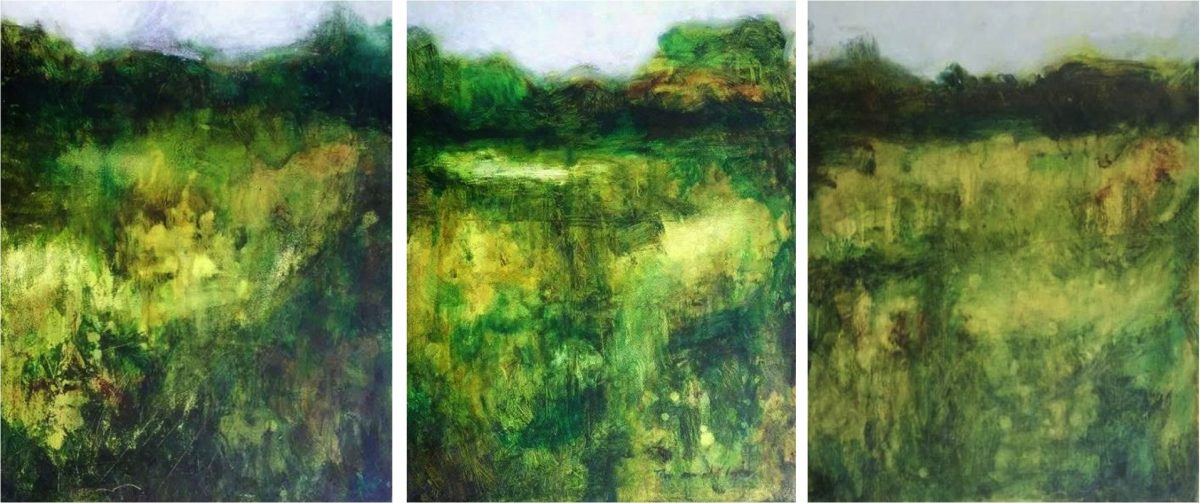
Katrine Claassens. Edith Stephens, I-III (left to right). Oil on wood. Illustrated stories originally published in The Nature of Cities.
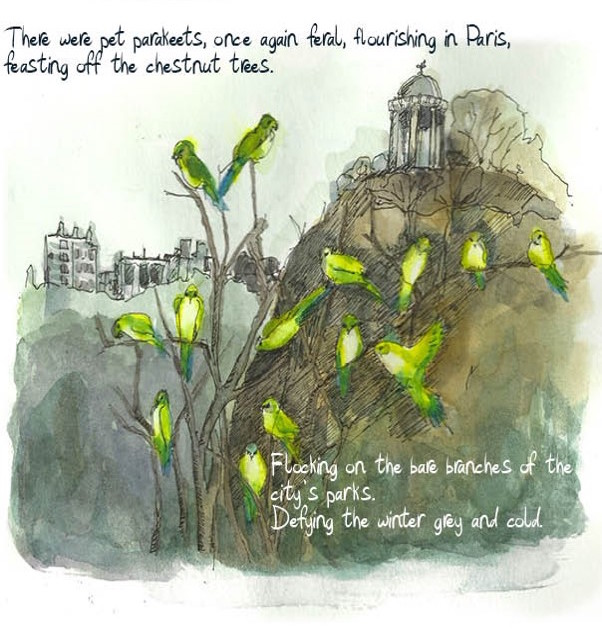
Katrine Claassens. World Enough: Tales from the Bottom of the Garden. Oil on wood. Illustrated story originally published on The Nature of Cities.
The Hive
Multi-Sensory Installation by Wolfgang Buttress
“The Hive”, a 44-ton metallic installation, meditatively rests on the grounds of the Kew Gardens in London, England. Visitors must walk through a field of wildflowers filled with pollinating honey bees to reach this 56-foot structure. Made from carefully crafted aluminum bars and rods, its spiralling form echoes that of a bee hive. Along with a team of artists, landscape architects, musicians, and a scientist, Wolfgang Buttress originally created it for the UK Pavilion at the 2015 Milan Expo. But its more than just a sculpture. Stimulated by the activity of 50,000 honey bees pollinating in the surrounding gardens, it creates an immersive, multisensorial experience through flickering real-time LED lights and harmonious sounds of musical instruments. Buttress wanted to gently convey the imperative of honey bees to our planet, since they pollinate over 30% of what humans eat. He was also intrigued by how nature builds structures, which he echoes in his seamless fusion of form and function. He hopes his harmonious and meditative form will encourage people to consider their place in the natural world.
The Hive at Kew Gardens from Kew Gardens on Vimeo.
